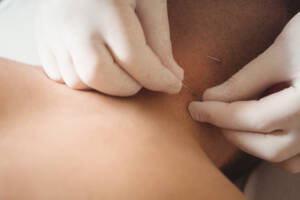In the world of pain management and rehabilitation, dry needling has gained popularity in recent years for its effectiveness. Like any other therapeutic treatment, it has its own set of potential risks and discomforts. One of the most concerning complications is when dry needling hits a nerve.
Today, we’ll take you through what happens when dry needling hits a nerve in this blog.
The Concept Of Dry Needling Therapy:
Dry needling is a therapeutic technique that involves the insertion of needles into trigger points in the muscle to reduce muscle pain and improve mobility. Trigger points are the actual tension points and the root cause of musculoskeletal pain.
Apart from several benefits, the therapy has its risks and discomforts, emphasizing the discussion of its pros and cons with the patient before initiating the treatment. Moreover, the risks and discomforts vary from patient to patient. Hence, a thorough assessment of the patient’s medical history becomes crucial.
Furthermore, it’s essential to know the legal status of dry needling therapy as it varies from every jurisdiction and whether the practitioner is experienced and licensed in performing dry needling.
Dry Needling And Nerve Injury
While dry needling is generally considered safe when performed by trained professionals, there are risks and complications involved in the treatment, including nerve injury. Nerves are delicate structures that transmit signals from the CNS to the rest of the body through the PNS.
When the needle is inserted into the trigger points to reduce muscle tension and pain, the nerves closer to the trigger points sometimes come in contact with the needle. The resulting temporary nerve sensation is known as a “twitch response” and is often considered a positive response of an effective dry needling treatment.
In rare cases, the contact between the needle and the nerve causes irritation or nerve damage. The symptoms of nerve damage include irritation, pain, and numbness. If the symptoms persist long, you must consult your healthcare provider immediately.
What Happens When Dry Needling Hits A Nerve?
If you experience any of the following symptoms, consider connecting with our licensed dry needling practitioners at ASAP and Rehab.

Immediate Pain and Discomfort :
Patients may experience sudden, sharp pain when the needle contacts a nerve. This discomfort can range from mild to severe and may radiate to other body parts connected to the affected nerve.
Nerve Irritation or Damage :
Symptoms after a needling mishap include nerve irritation, nerve damage, numbness, or weakness in the surrounding areas. These symptoms may persist after the dry needling session.
Inflammation and Swelling :
Injury to the nerve can trigger an inflammatory response, resulting in localized swelling, redness, and tenderness. In some cases, the inflammation may worsen the symptoms and prolong the healing process.
Potential Complications :
Severe nerve injuries may cause long-term complications, including neuropathy (nerve damage), motor dysfunction, or sensory deficits. These consequences can significantly impact a person’s quality of life and require specialized medical intervention.
Precautions To Prevent Nerve Injury
To minimize and manage pain from nerve hits during dry needling, practitioners should:
- Conduct a thorough assessment of the patient’s medical history, including any underlying conditions or previous nerve injuries.
- Utilize precise needle insertion techniques and avoid areas with known nerve pathways.
- Communicate with the patient throughout the procedure to monitor for any signs of discomfort or unusual sensations.
- Respond promptly to any adverse reactions and provide appropriate follow-up care, including referral to a specialist if necessary.
Conclusion:
Dry needling is an effective treatment for musculoskeletal pain, but the potential risk of nerve injury emphasizes the importance of proper training and cautious practice.
Communicate with the patients priorly about the risks associated with the treatment and encourage them to communicate any concerns or adverse reactions during the treatment with their healthcare provider.
At ASAP and Rehab, our dry needling practitioners prioritize safety and vigilance, minimizing the likelihood of nerve injury and optimizing the therapeutic benefits of dry needling for the patients.



1 Comment
Comments are closed.